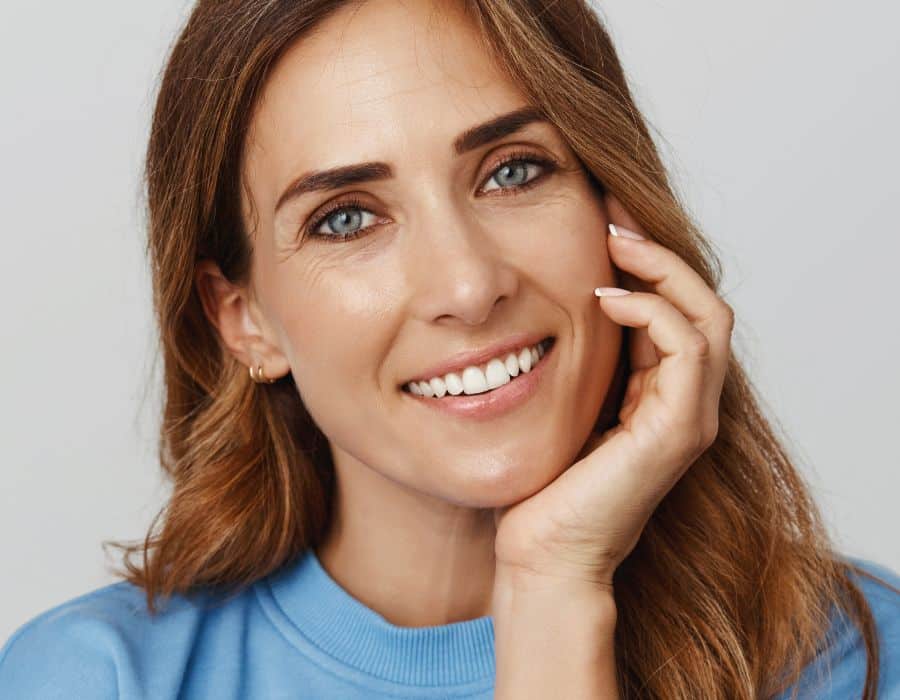Fat Transfer in Phoenix, AZ
Many men and women have regions of their bodies where they would like less volume and other areas where they would like more. Sadly, fat never seems to stay or develop where you want it, and it feels impossible to remove from places you do not. Fat transfer is the ideal procedure for this dilemma since it moves fat from one area of the body to another to improve body, facial, and breast contouring.
What Can Fat Transfer Achieve?

Restored Facial Volume and Skin Quality
Aging, gravity, genetics, sun damage, and weight fluctuations cause the facial fat around the cheeks, mouth, temples, or beneath the eye to sag toward the jawline and create jowls. Fat transfer to the face restores volume and recreates youthful facial contours.

Rejuvenated Facial Contours
Fine lines and wrinkles develop across the face as collagen and elastin diminish. The thinning of the skin causes lines to gather around the mouth, nose, and eyes. Fat transfer to these areas fill the crevices and restores smooth skin. For some patients, fat transfer provides a less invasive alternative to a facelift.

Enhanced Breast Volume
Some women experience changes in breast appearance with age, pregnancy, weight, and hormone fluctuations. Fat transfer to the breasts allow patients who want larger breasts but do not feel comfortable using implants to achieve that desire.
Fat Transfer Procedure
Liposuction
Fat transfer requires fat to be taken from the body before injection. This is done in steps with liposuction:
- The harvesting area (usually the abdomen, thighs, hips, buttocks, or back) is numbed, and tumescent fluid is injected to break up the fat cells for easier and less-traumatic removal of the cells.
- The fat cells are removed through a cannula, and the undamaged cells are separated and isolated.
- The healthy fat cells are cleansed and prepared for injection into the desired areas of enhancement.
- The liposuction sites may be closed with sutures, and drains may be placed to assist with drainage and the healing process.
Fat Transfer to the Face
Excess fat is harvested from the body and injected into aged or hollowed regions of the face. Usual areas for fat transfer include the cheeks, chin, jawline, temples, forehead, nose, and under the eye.
Fat Transfer to the Breasts
Harvested fat is injected into various regions of the breast to add fullness and shape. This technique will only result in a small amount of increase but will provide a natural-looking appearance and feel.
Concerns
Recovery
Your liposuction incisions will be wrapped in dressings that help reduce swelling by promoting circulation. The harvesting and transfer sites will experience bruising and swelling that may take days or weeks to dissipate entirely. While you should take it easy for the first few days, getting on your feet is the best way to increase circulation and speed the recovery period. You want to be sure that you do not overexert yourself; all strenuous activity should be limited for at least four weeks.
Scars
Scarring may develop from the liposuction incisions. These incisions are small, and the scars are often inconspicuous once they have healed. There is usually no scarring at the transfer sites because the fat is injected with a thin needle.
Fat transfer patients can reduce their post-operative scarring by keeping their healing incisions out of the sun and applying silicone strips and gel. All scars will fade with time.
Cost
The cost of your fat transfer varies depending on the areas of enhancement and the amount of fat being transferred to that area. Additional cost factors include anesthesia fees, facility room fees, surgical fees, and post-surgical dressings and medications.
Pain
Liposuction is performed under anesthesia, and the fat injection sites are numbed for comfort and safety. You may experience discomfort once this anesthesia wears off at both the harvesting and transfer areas. Any discomfort can be relieved by oral pain medication, over-the-counter medication like TYLENOL®, cold compresses, and rest. The bruising and swelling will begin to lessen within a few days.

Frequently Asked Questions
Is fat transfer permanent?
Not all of the harvested and transferred fat will survive. Occasionally, repeated treatments are necessary to obtain optimal results.
The fat that does survive will be long lasting as the body does not absorb it or break it down as other injectable treatments, such as dermal fillers.
It can take up to six months for your fat transfer results to fully develop.
Are there any risks with fat transfer?
Fat is beneficial over other injections/implants because there is almost no chance of rejection or allergic reaction. As fat transfer requires liposuction, however, there are rare side effects that can occur. These include:
- Complications from anesthesia
- Bleeding
- Infection
- Prolonged swelling
- Poor scarring at liposuction sites
- Asymmetry or uneven quality to harvesting areas
Is everyone a candidate for fat transfer?
Candidates for fat transfer must have an adequate amount of fat elsewhere on their body that can be harvested through liposuction. This fat can come from any region of the body, but it must come from their own body.
What are the alternatives to fat transfer?
Fat transfer is an organic way to restore volume to areas that have lost it or never had it. Unfortunately, not every potential patient has enough fat on their body to harvest. These patients will need to seek out alternative treatments to restore or create volume.
- Dermal fillers like JUVÉDERM®, Restylane®, and RADIESSE® restore temporarily restore facial volume and does not require surgery.
- Breast augmentation with implants enhances the volume and shape of the breasts. Implants are available in a wide variety of styles.
Want to Learn More About Brow Lift in Phoenix, AZ?
To learn more about brow lift and your options in Phoenix, AZ, call our office at (480) 833-5200 or fill out our online contact form today to schedule your consultation.

Kind Words From Our Patients
“Thank you all for your professional compassion and kindness while I was your patient. I feel good and appreciate all that you all have done for me. You are the best!”
“I could not have asked for better care. Dr.Boll, along with her staff, are the consummate professionals. I made a consultation appointment with Dr. Boll to discuss a facelift. She discussed, in depth, every aspect of the procedure including what I could expect for an outcome. Her kindness and compassion are genuine. Her knowledge unparalleled. I left that consultation knowing I had made the right decision.”
“Post- surgery attention was outstanding, I felt completely comfortable in Dr. Boll’s care; and I am 68, never having surgery before.”
“Thank you all for your professional compassion and kindness while I was your patient. I feel good and appreciate all that you all have done for me. You are the best!”
“I could not have asked for better care. Dr.Boll, along with her staff, are the consummate professionals. I made a consultation appointment with Dr. Boll to discuss a facelift. She discussed, in depth, every aspect of the procedure including what I could expect for an outcome. Her kindness and compassion are genuine. Her knowledge unparalleled. I left that consultation knowing I had made the right decision.”
“Post- surgery attention was outstanding, I felt completely comfortable in Dr. Boll’s care; and I am 68, never having surgery before.”
